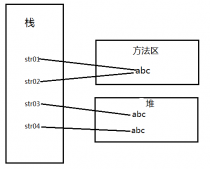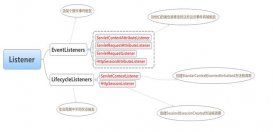前言
之前一篇文章介绍了基本的统一异常处理思路: spring mvc/boot 统一异常处理最佳实践.
上篇文章也有许多人提出了一些问题:
- 如何区分 ajax 请求和普通页面请求, 以分别返回 json 错误信息和错误页面.
- 如何结合 http 状态码进行统一异常处理.
今天这篇文章就主要来讲讲这些, 以及其他的一些拓展点.
区分请求方式
其实 spring boot 本身是内置了一个异常处理机制的, 会判断请求头的参数来区分要返回 json 数据还是错误页面. 源码为: org.springframework.boot.autoconfigure.web.servlet.error.basicerrorcontroller, 他会处理 /error 请求. 核心处理代码如下:
|
1
2
3
4
5
6
7
8
9
10
11
12
13
14
15
16
17
18
19
20
21
22
23
24
25
26
|
@requestmapping( produces = {"text/html"})// 如果请求头是 text/html, 则找到错误页面, 并返回public modelandview errorhtml(httpservletrequest request, httpservletresponse response) { // 1. 获取 http 错误状态码 httpstatus status = this.getstatus(request); // 2. 调用 geterrorattributes 获取响应的 map 结果集. map<string, object> model = collections.unmodifiablemap(this.geterrorattributes(request, this.isincludestacktrace(request, mediatype.text_html))); // 3. 设置响应头的状态码 response.setstatus(status.value()); // 4. 获取错误页面的路径 modelandview modelandview = this.resolveerrorview(request, response, status, model); return modelandview != null ? modelandview : new modelandview("error", model);}@requestmapping@responsebodypublic responseentity<map<string, object>> error(httpservletrequest request) { // 调用 geterrorattributes 获取响应的 map 结果集. map<string, object> body = this.geterrorattributes(request, this.isincludestacktrace(request, mediatype.all)); // 获取 http 错误状态码 httpstatus status = this.getstatus(request); // 返回给页面 json 信息. return new responseentity(body, status);} |
这两个方法的共同点是: 他们都调用了 this.geterrorattributes(…) 方法来获取响应信息.
然后来看看他默认情况下对于 ajax 请求和 html 请求, 分别的返回结果是怎样的:

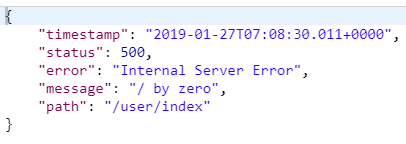
对于返回错误页面, 其中还调用了一个非常重要的方法: this.resolveerrorview(...) 方法, 源码我就不带大家看了, 他的作用就是根据 http 状态码来去找错误页面, 如 500 错误会去找 /error/500.html, 403 错误回去找 /error/403.html, 如果找不到则再找 /error/4xx.html 或 /error/5xx.html 页面. 还找不到的话, 则会去找 /error.html 页面, 如果都没有配置, 则会使用 spring boot 默认的页面. 即:

看到这里, 应该就清楚了, 我们主要需要做四件事:
- 发送异常后, 重定向到 basicerrorcontroller 来处理 (既然spring boot 都已经写好了区分请求的功能, 我们就不必要再写这些判断代码了)
- 自定义 http 错误状态码
-
他返回的信息格式可能不是我们想要的, 所以必须要改造
geterrorattributes(...)方法, 以自定义我们向页面返回的数据. (自定义错误信息) - 创建我们自己的 /error/4xx.html 或 /error/5xx.html 等页面, (自定义错误页面)
basicerrorcontroller
第一点很简单, basicerrorcontroller 他处理 /error 请求, 我们只需要将页面重定向到 /error 即可, 在 controlleradvice 中是这样的:
|
1
2
3
4
5
6
7
8
9
|
@controlleradvicepublic class webexceptionhandler { @exceptionhandler public string methodargumentnotvalid(bindexception e) { // do something return "/error"; }} |
自定义 http 错误状态码
我们来看下 this.getstatus(request); 的源码, 看他原来时如何获取错误状态码的:
|
1
2
3
4
5
6
7
8
9
10
11
12
|
protected httpstatus getstatus(httpservletrequest request) { integer statuscode = (integer)request.getattribute("javax.servlet.error.status_code"); if (statuscode == null) { return httpstatus.internal_server_error; } else { try { return httpstatus.valueof(statuscode); } catch (exception var4) { return httpstatus.internal_server_error; } }} |
简单来说就是从 request 域中获取 javax.servlet.error.status_code 的值, 如果为 null 或不合理的值, 都返回 500. 既然如何在第一步, 重定向到 /error 之前将其配置到 request 域中即可, 如:
|
1
2
3
4
5
6
7
8
9
10
|
@controlleradvicepublic class webexceptionhandler { @exceptionhandler public string methodargumentnotvalid(bindexception e, httpservletrequest request) { request.setattribute("javax.servlet.error.status_code", 400); // do something return "forward:/error"; }} |
自定义错误信息
也就是 geterrorattributes 方法, 默认的代码是这样的:
|
1
2
3
4
5
6
7
8
|
public map<string, object> geterrorattributes(webrequest webrequest, boolean includestacktrace) { map<string, object> errorattributes = new linkedhashmap(); errorattributes.put("timestamp", new date()); this.addstatus(errorattributes, webrequest); this.adderrordetails(errorattributes, webrequest, includestacktrace); this.addpath(errorattributes, webrequest); return errorattributes;} |
他获取了时间戳, 错误状态码, 错误信息, 错误路径等信息, 和我们之前看到默认的返回内容是一致的:
|
1
2
3
4
5
6
7
|
{ "timestamp": "2019-01-27t07:08:30.011+0000", "status": 500, "error": "internal server error", "message": "/ by zero", "path": "/user/index"} |
同样的思路, 我们将错误信息也放到 request 域中, 然后在 geterrorattributes 中从 request 域中获取:
|
1
2
3
4
5
6
7
8
9
10
11
12
|
@controlleradvicepublic class webexceptionhandler { @exceptionhandler public string methodargumentnotvalid(bindexception e, httpservletrequest request) { request.setattribute("javax.servlet.error.status_code", 400); request.setattribute("code", 1); request.setattribute("message", "参数校验失败, xxx"); // do something return "forward:/error"; }} |
再继承 defaulterrorattributes 类, 重写 geterrorattributes 方法:
|
1
2
3
4
5
6
7
8
9
10
11
12
13
14
15
16
17
|
//@componentpublic class mydefaulterrorattributes extends defaulterrorattributes { @override //重写 geterrorattributes方法-添加自己的项目数据 public map<string, object> geterrorattributes(webrequest webrequest, boolean includestacktrace) { map<string, object> map = new hashmap<>(); // 从 request 域中获取 code object code = webrequest.getattribute("code", requestattributes.scope_request); // 从 request 域中获取 message object message = webrequest.getattribute("message", requestattributes.scope_request); map.put("code", code); map.put("message", message); return map; }} |
自定义错误页面
我们遵循 springboot 的规则, 在 /error/ 下建立 400.html, 500.html 等页面细粒度的错误, 并配置一个 /error.html 用来处理细粒度未处理到的其他错误.
/error/400.html
|
1
2
3
4
5
6
7
8
9
10
11
12
|
<!doctype html><html lang="en" xmlns:th="http://www.thymeleaf.org"><head> <meta charset="utf-8"> <title>400</title></head><body> <h1>400</h1> <h1 th:text="$[code]"></h1> <h1 th:text="${message}"></h1></body></html> |
/error/500.html
|
1
2
3
4
5
6
7
8
9
10
11
12
|
<!doctype html><html lang="en" xmlns:th="http://www.thymeleaf.org"><head> <meta charset="utf-8"> <title>500</title></head><body> <h1>500</h1> <h1 th:text="$[code]"></h1> <h1 th:text="${message}"></h1></body></html> |
/error.html
|
1
2
3
4
5
6
7
8
9
10
11
12
|
<!doctype html><html lang="en" xmlns:th="http://www.thymeleaf.org"><head> <meta charset="utf-8"> <title>系统出现了错误</title></head><body> <h1>error page</h1> <h1 th:text="$[code]"></h1> <h1 th:text="${message}"></h1></body></html> |
测试效果
到此位置, 大功告成, 然后来创造一个异常来测试一下效果:
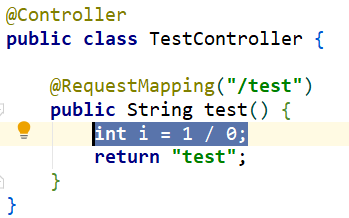
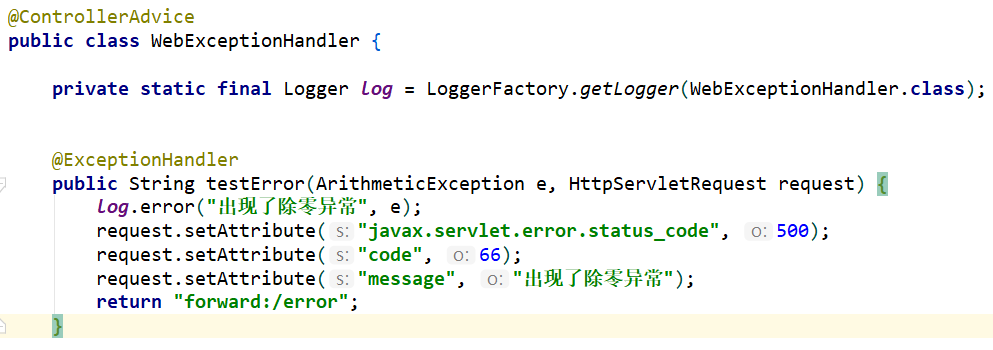
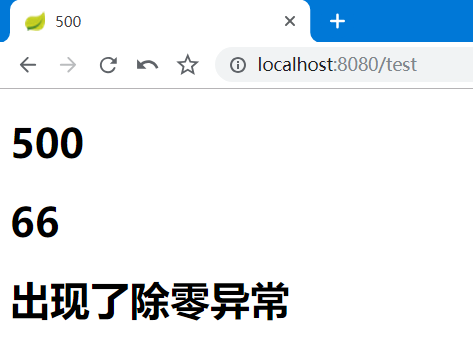
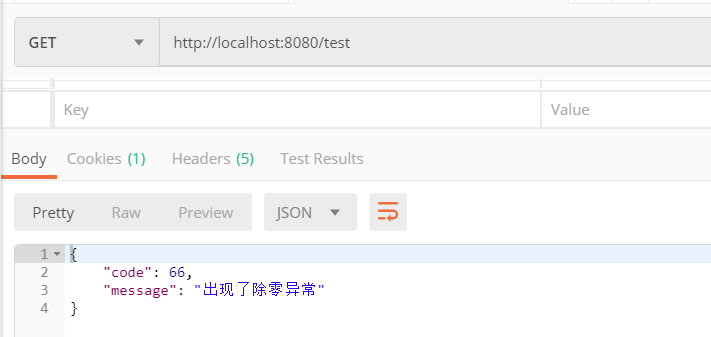
前端 error 处理
现在使用了 http 状态码, 所以 ajax 请求出现错误后, 需要在每个 ajax 请求方法中都写 error: function() {} 方法, 甚至麻烦. 好在 jquery 为我们提供了全局处理 ajax 的 error 结果的方法 ajaxerror() :
|
1
2
3
4
5
|
$(document).ajaxerror(function(event, response){ console.log("错误响应状态码: ",response.status); console.log("错误响应结果: ",response.responsejson); alert("an error occurred!");}); |
结语
回顾一下讲到的这些内容:
- 理解 springboot 默认提供的 basicerrorcontroller
-
自定义 http 错误状态码, (通过 request 域的
javax.servlet.error.status_code参数) - 自定义错误信息, (将我们自定义的错误信息放到 request 域中, 并重写 defaulterrorattributes 的 geterrorattributes 方法, 从 request 域中获取这些信息).
- 自定义错误页面, (根据 springboot 查找错误页面的逻辑来自定义错误页面: /error/500.html, /error/400.html, /error.html)
可以自己根据文章一步一步走一遍, 或者看我写好的演示项目先看看效果, 总是动手实践, 而不是收藏文章并封存。
演示项目地址:https://github.com/zhaojun1998/exception-handler-demo
总结
以上就是这篇文章的全部内容了,希望本文的内容对大家的学习或者工作具有一定的参考学习价值,如果有疑问大家可以留言交流,谢谢大家对服务器之家的支持。
原文链接:http://www.zhaojun.im/springboot-exception-expand/


